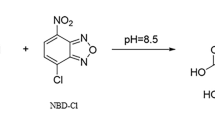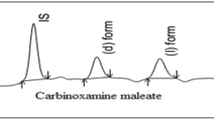Abstract
A quantitative method for the simultaneous HPLC resolution and detection of the enantiomers of (R,S) fluoxetine (F) and their metabolites (R,S) norfluoxetine (N) in human plasma has been developed. F is a serotonin uptake inhibitor used in the treatment of depression and is administered as a racemate. After liquid–liquid extraction and derivatization with (R) napthyl ethyl isocyanate (NEI), the separation and detection of the resultant diasteriomers were achieved using normal phase HPLC and fluorescence. The four NEI diastereomers and the internal standard [(–)-N-methyl-γ-(2-methylphenoxy) benzenepropanamine hydrochloride], representing the enantiomers S-F, R-F, S-N, and R-N were resolved within 15 min. The assay for each analyte was linear using two concentration ranges of 1–10 and 10–500 ng/ml of human plasma. The precision and accuracy are reported as the coefficient of variation (%CV) and relative error (%RE). The sum of the chiral HPLC results from plasma samples were compared to the achiral gas chromatographic/electron capture (GC/EC) results. The correlation between these two methods, for total F and N, resulted in r 2 values of 0.98 and 0.89, respectively. The chiral HPLC method is currently being applied to clinical studies for the evaluation of the enantiomeric disposition of F.
Similar content being viewed by others
REFERENCES
P. Benfield, R. C. Heel, and S. P. Lewis. Fluoxetine, A review of its pharmacodynamic and pharmacokinetic properties, and therapeutic efficacy in depressive illness. In Centorian (ed.), Drugs, ADIS Press Limited, New Zealand, V32, N6.481–508 (1986).
L. Lemberger, H. Rowe, R. Carmichael, J. Hornig, F. Bymaster, and D. Wong. Pharmacologic effects in man of a specific serotonin-reuptake inhibitor. Science 199:436–437 (1978).
J. F. Nash, R. J. Bopp, R. H. Carmichael, K. Z. Farid, and L. Lemberger. Determination of fluoxetine and norfluoxetine in plasma by gas chromatography with electron-capture detection. Clin. Chem. 28:2100–2102 (1982).
S. H. Wong, S. S. Dellafera, R. Fernandes, and H. K. Ranzler. Determination of fluoxetine and norfluoxetine by high-performance liquid chromatography. J. Chromatogr. 499:601–608 (1990).
R. L. Wolen, R. F. Bergstrom, J. B. Tenbarge, and L. Lemberger. Fluoxetine enantiomer disposition in plasma and urine of normal subjects and patients. Pharm. Res. 6(9):S221 (1989).
B. D. Potts, C. R. Wethington, and C. J. Parli. Development of an indirect HPLC enantiomer separation technique for the analysis of plasma concentrations of R and S-fluoxetine in animals dosed with fluoxetine. Pharmacologist 31:153 (1989).
R. Abbott, Personal communication, Eli Lilly and Company.
Author information
Authors and Affiliations
Rights and permissions
About this article
Cite this article
Peyton, A.L., Carpenter, R. & Rutkowski, K. The Stereospecific Determination of Fluoxetine and Norfluoxetine Enantiomers in Human Plasma by High-Pressure Liquid Chromatography (HPLC) with Fluorescence Detection. Pharm Res 8, 1528–1532 (1991). https://doi.org/10.1023/A:1015802702064
Issue Date:
DOI: https://doi.org/10.1023/A:1015802702064




